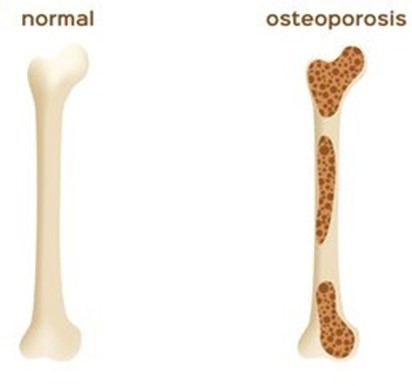A nurse is collecting data from a female client who has anorexia nervosa. Which of the following findings should the nurse expect?
Decreased cholesterol levels
Heavy monthly periods
Elevated serum potassium level
Low bone density
The Correct Answer is D
When collecting data from a female client who has anorexia nervosa, the nurse should expect a finding of low bone density.
Anorexia nervosa is an eating disorder characterized by self-starvation, distorted body image, and a fear of gaining weight. Clients with anorexia nervosa are at risk for severe malnutrition, which can lead to a variety of complications, including bone loss and osteoporosis.

Options A, B, and C are incorrect findings in a client with anorexia nervosa. Decreased cholesterol levels may be an indication of malnutrition. Heavy monthly periods, or menstrual irregularities, may occur in clients with anorexia nervosa because of the hormonal changes that can result from severe weight loss. Elevated serum potassium levels are not a common finding in a client with anorexia nervosa.
Nursing Test Bank
Naxlex Comprehensive Predictor Exams
Related Questions
Correct Answer is B
Explanation
Increasing feelings of anger are a common symptom of PTSD after a sexual assault, as survivors may feel violated, powerless, or betrayed by the perpetrator or others. Anger can also be a way of coping with fear, anxiety, or guilt that may arise from the trauma.
Choice A is not correct because the increasing sense of attachment to others is not a typical response to sexual assault. Survivors may experience difficulties in trusting or relating to others, especially those who remind them of the assault or who do not support them.
Choice C is not correct because the constant need to talk about the event is not a characteristic of PTSD. Survivors may avoid thinking or talking about the trauma, as it can trigger distressing emotions or memories. Some survivors may choose to share their experiences with others, but this does not indicate PTSD.
Choice D is not correct because sleeping 12 hr or more each day is not an expected finding of PTSD after a sexual assault. Survivors may have trouble falling or staying asleep, or experience nightmares or flashbacks that disrupt their sleep quality. Sleeping too much can also be a sign of depression, which can co-occur with PTSD.
Correct Answer is C
Explanation
"Be direct and honest when communicating with the client." Being direct and honest with the client about the situation is essential to build trust and promote open communication. Protecting client confidentiality and privacy is crucial for client safety and well-being. If the client feels comfortable in a safe and non-threatening environment, then they are more likely to open up and discuss their situation. Displaying disapproval or probing the client can make the situation worse and result in the client withdrawing further. Inviting a family member to be present during the nursing history is not appropriate given the sensitive and personal nature of the discussion.
Option A: "Display disapproval toward the perpetrator" - Not appropriate for the clinical setting
Option B: "Probe the client to offer a factual account of the abuse" May make the client withdraw more, not appropriate for the clinical setting
Option D: "Invite a family member to be present for the nursing history" - Not appropriate for the sensitive nature of the discussion Each of the other options is not appropriate given the sensitive nature of the conversation.
Whether you are a student looking to ace your exams or a practicing nurse seeking to enhance your expertise , our nursing education contents will empower you with the confidence and competence to make a difference in the lives of patients and become a respected leader in the healthcare field.
Visit Naxlex, invest in your future and unlock endless possibilities with our unparalleled nursing education contents today
Report Wrong Answer on the Current Question
Do you disagree with the answer? If yes, what is your expected answer? Explain.
Kindly be descriptive with the issue you are facing.
